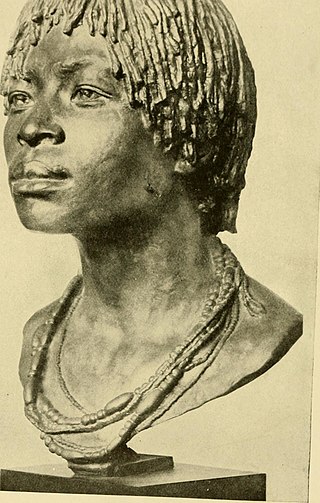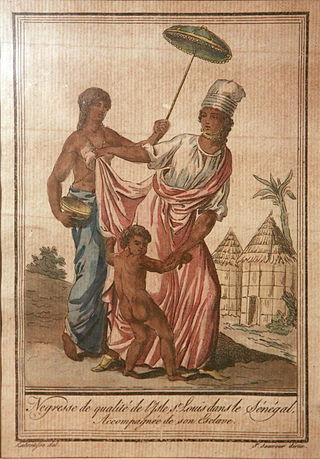People have inhabited the region now known as Guinea-Bissau for thousands of years. In the 13th century, it became a province of the Mali Empire that later became independent as the Empire of Kaabu. Portugal claimed the region beginning in the 1450s. During most of this period, Portuguese control of the region was limited to a number of forts along the coast. Portugal gained full control of the mainland after the pacification campaigns of 1912–15. The offshore Bijagos islands were not colonised until 1936. After gaining independence in 1974, the country was controlled by a single-party system until 1991. The introduction of multi-party politics in 1991 brought the first multi-party elections in 1994. A civil war broke out in 1998 and lasted until 1999.

The Atlantic slave trade or transatlantic slave trade involved the transportation by slave traders of enslaved African people to the Americas. European slave ships regularly used the triangular trade route and its Middle Passage. Europeans established a coastal slave trade in the 15th century and trade to the Americas began in the 16th century, lasting through the 19th century. The vast majority of those who were transported in the transatlantic slave trade were from Central Africa and West Africa and had been sold by West African slave traders to European slave traders, while others had been captured directly by the slave traders in coastal raids. European slave traders gathered and imprisoned the enslaved at forts on the African coast and then brought them to the Americas. Except for the Portuguese, European slave traders generally did not participate in the raids because life expectancy for Europeans in sub-Saharan Africa was less than one year during the period of the slave trade. Portuguese coastal raiders found that slave raiding was too costly and often ineffective and opted for established commercial relations.

Triangular trade or triangle trade is a historical term indicating trade among three ports or regions. Triangular trade usually evolves when a region has export commodities that are not required in the region from which its major imports come. Triangular trade thus provides a method for rectifying trade imbalances between the above regions.

Nzinga Ana de Sousa Mbande, Nzhinga was a southwest African ruler who ruled as queen of the Ambundu Kingdoms of Ndongo (1624–1663) and Matamba (1631–1663), located in present-day northern Angola. Born into the ruling family of Ndongo, her grandfather Ngola Kilombo Kia Kasenda was the king of Ndongo.

The Kongo people are a Bantu ethnic group primarily defined as the speakers of Kikongo. Subgroups include the Beembe, Bwende, Vili, Sundi, Yombe, Dondo, Lari, and others.

The earliest humans were hunter gatherers who were living in small, family groupings. Even then there was considerable trade that could cover long distances. Archaeologists have found that evidence of trade in luxury items like precious metals and shells across the entirety of the continent.

Elmina Castle was erected by the Portuguese in 1482 as Castelo de São Jorge da Mina, also known as Castelo da Mina or simply Mina, in present-day Elmina, Ghana, formerly the Gold Coast. It was the first trading post built on the Gulf of Guinea, and the oldest European building in existence south of the Sahara.

The first wave of European colonization began with Spanish and Portuguese conquests and explorations, and primarily involved the European colonization of the Americas, though it also included the establishment of European colonies in India and in Maritime Southeast Asia. During this period, European interests in Africa primarily focused on the establishment of trading posts there, particularly for the African slave trade. The wave ended with the British annexation of the Kingdom of Kandy in 1815 and the founding of the colony of Singapore in 1819.

Slavery has historically been widespread in Africa. Systems of servitude and slavery were once commonplace in parts of Africa, as they were in much of the rest of the ancient and medieval world. When the trans-Saharan slave trade, Red Sea slave trade, Indian Ocean slave trade and Atlantic slave trade began, many of the pre-existing local African slave systems began supplying captives for slave markets outside Africa. Slavery in contemporary Africa is still practised despite it being illegal.
Arsénio Pompílio Pompeu de Carpo (1792–1869) was a Portuguese slave trader, freemason, poet and journalist, who was active mainly in Angola and Brazil.

Panyarring was the practice of seizing and holding persons until the repayment of debt or resolution of a dispute which became a common activity along the Atlantic coast of Africa in the 18th and 19th centuries. The practice developed from pawnship, a common practice in West Africa where members of a family borrowing money would be pledged as collateral to the family providing credit until the repayment of the debt. Panyarring though is different from this practice as it involves the forced seizure of persons when a debt was not repaid.

Signares were black and mulatto Senegalese women who had an influence via their marriage with European men and their patrimony. These women of color managed to gain some individual assets, status, and power in the hierarchies of the Atlantic slave trade.

The Atlantic slave trade to Brazil occurred during the period of history in which there was a forced migration of Africans to Brazil for the purpose of slavery. It lasted from the mid-sixteenth century until the mid-nineteenth century. During the trade, more than three million Africans were transported across the Atlantic and sold into slavery. It was divided into four phases: The cycle of Guinea ; the cycle of Angola which trafficked people from Bakongo, Mbundu, Benguela, and Ovambo; cycle of Costa da Mina, now renamed Cycle of Benin and Dahomey, which trafficked people from Yoruba, Ewe, Minas, Hausa, Nupe, and Borno; and the illegal trafficking period, which was suppressed by the United Kingdom (1815–1851). During this period, to escape the supervision of British ships enforcing an anti-slavery blockade, Brazilian slave traders began to seek alternative routes to the routes of the West African coast, turning to Mozambique.
Ana Joaquina dos Santos e Silva, was a Euro-African Nhara slave trader, money lender, and planter in Angola. She was the perhaps biggest slave trader in Angola, which traded with Brazil during the 1830s, and financed the expedition of Joaquim Rodrigues Graça.
Mary Faber, also called Mary Faber de Sanger, was an African slave-trader. From the 1830s until 1852, she was a dominant figure of the Atlantic slave trade from Guinea, and known for her conflict with the British Royal Navy Anti-Slave Squadron.
Crispina Peres was an African "Senhora" slave trader, natural from Geba, nowadays Guinea-Bissau.
Julia da Silva Cardoso also known as Mae Julia and Na Julia, was a Euro-African nhara slave trader.
Rosa de Carvalho Alvarenga also known as Dona Rosa de Cacheu and Na Rosa, was a Euro-African nhara slave trader.
Dona Aurelia Correia, also known as Mae Aurelia, Mame Correia Aurelia and Madame Oralia, was a Euro-African nhara slave trader. She was titled "Queen of Orango" by Portuguese and Luso-Africans. Aurelia, a slave trader from West Africa, is believed to have been born from a probable relationship between a trader from Cape Verde and a local woman. She was a dominant key figure in the business life of Guinea-Bissau during the first half of the 19th-century. She is regarded as the most famous of the nhara-community of the region, was regarded as an important member of the community by the Portuguese and described as a powerful businesswoman in oral African tradition. She was the fosterchild and possibly maternal niece of Julia da Silva Cardoso, and the de facto wife of the businessman Caetano José Nozolini (1800-1850), Portuguese governor of Cape Verde. On her mother’s side Correia descended from the Bijagó, the ruling matrilineage on the island of Orango, the largest and most important in the archipelago of the Guinea coast.
Elizabeth Frazer Skelton also called "Mammy Skelton" (1800–1855) was a Euro-African slave trader.










